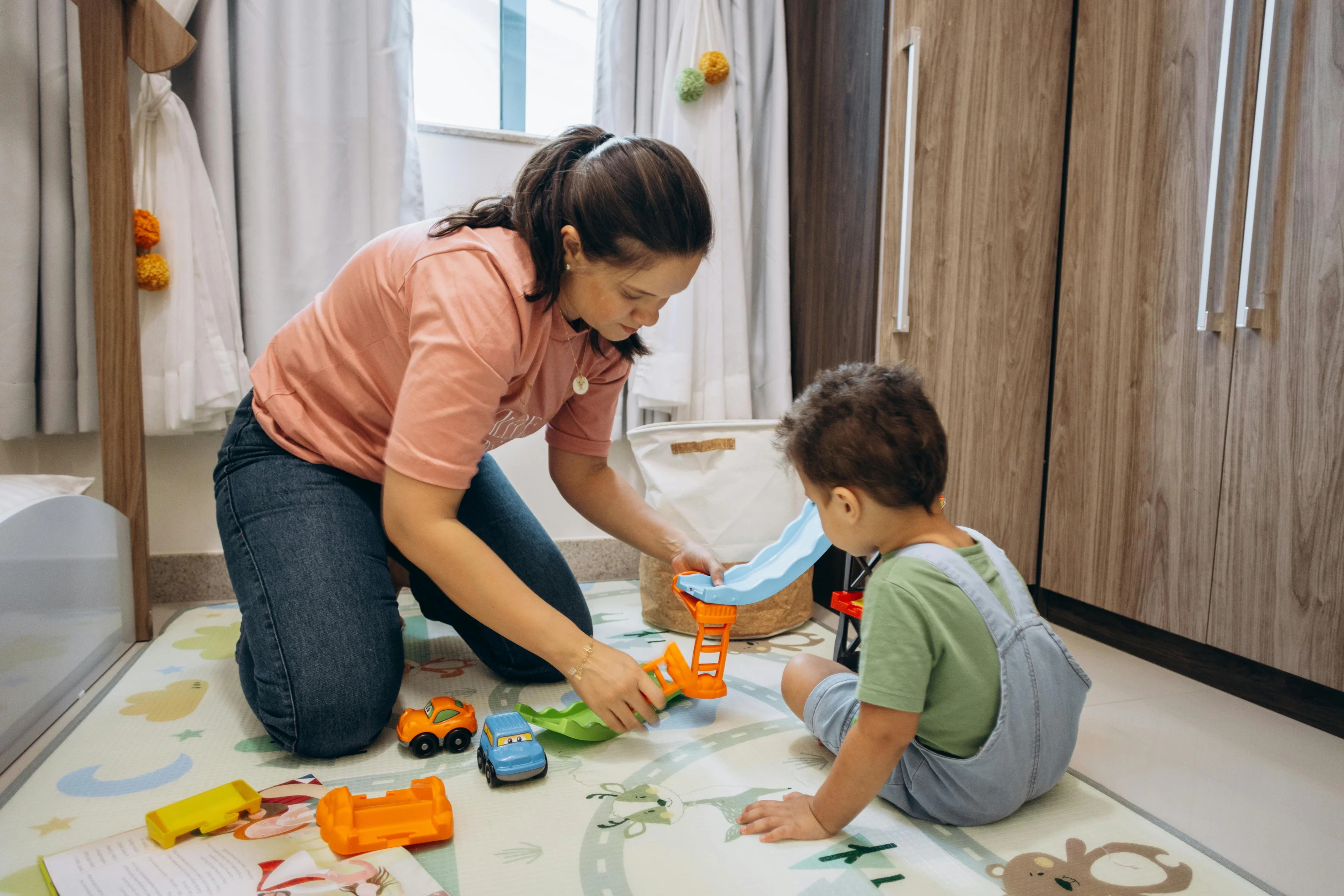
Have you ever wondered how children develop new skills or how they begin to make new connections and learn new concepts? How do they learn to talk, understand language, and communicate? Have you ever considered how they develop physical skills so that they can crawl, then walk, run, jump, climb, and manipulate objects, such as a spoon? How do they learn to control their emotions and start to develop their own values and ideas?
Child development doesn’t happen by magic. It takes hundreds of adult interactions to enable a baby to develop into an independent child. Those interactions need to be patient, caring, playful and understanding. We humans are born completely dependent on our parents and we take a long time to achieve independence, similar to orangutans who nurse their young for up to six years.
That means the adult’s role is crucial in scaffolding child development. Our role is to protect and nurture our child, feeding and caring for them, modeling new language patterns when they are ready, and supporting them physically as they take their first steps and learn to walk. We are there to model kindness and empathy and provide them with the resources they need as they pass through each stage of development.
When we build a house, we need firm scaffolding to surround the house before we can add essential elements like windows, guttering, and a roof to complete the finished building. Those supportive structures are there to hold up the house, allowing us to protect it as we keep building up, brick by brick. To take the analogy further, if we try to build too high before the foundations are firmly set, the house won’t be secure. If we try to put the roof tiles on before the walls are completed, the house will have leaks and problems in its structure. If we miss a stage out, the house will be more vulnerable to the elements. Trying to build upwards too quickly means the house will be unstable.
In the same way, we need to scaffold children’s development by providing the opportunities they need to learn at the right time for them. Rushing children onto the next stage before they have firm foundations in place, can lead to gaps (or leaks) in their learning later on. It is better to build a firm and secure base than move on to the next stage too quickly.
Children don’t develop along a straight line. Each child is unique and each child will have different life experiences. Some children will make rapid progress but then slow down. Other children may appear to be behind in their development, but can suddenly catch up. Most young learners have peaks and dips in their learning journey because a child develops when and only when they are ready and the right building blocks are already in place to be able to build on.
As adults, we can do plenty to support and scaffold child development.
That’s because all children need three essential ingredients:
1. Adult Role Models

Children need adults who support learning by sensitively responding to them. We need to show children how to be kind, caring and respectful so that they too become kind, caring and respectful citizens. We also need to encourage children to try out new experiences and be brave enough to have a go at new and different activities and opportunities. We can scaffold children’s learning by encouraging children to explore and investigate new ideas and experiences, with us as their safety net, if they get it wrong. That way, they will build the confidence to eventually try out their own ideas.
Adopting a playful approach is essential. We need to make their learning process as fun as we possibly can, so that children want to learn and find out about the world around them and they build a good attitude to learning. We want them to develop skills like:
Curiosity
Exploration
Early Problem solving
Trial and error
Patience
Resilience
Perseverance
A good routine is key to children learning successfully. Just like scaffolding, a consistent routine provides a structure to learn within a safe and secure environment. It will have consistent adults and clear boundaries. As adults, we are key in providing this. Carefully observing children to find out what interests or motivates them is crucial. We can then use this information to encourage, challenge and teach them to learn new concepts. Lastly, children also need other children to play alongside them. It is the adult’s role to scaffold those interactions and early friendships by encouraging children to try and work things out for themselves, only stepping in if necessary.
2. Enticing Experiences
The experiences we provide for young children should always be appropriate to their stage of development. But whatever their stage, all children learn best through hands-on, real-life, and experiential learning. They need adults to support them to explore, use all their senses, repeat things, copy, and practice new learning.
Having access to outdoor space is vital as young children need plenty of space to use their bodies to test their own strength, and challenge themselves physically. We need to scaffold activities for them that are safe and secure but have plenty of challenge and safe physical risks. Providing opportunities to develop both gross and fine motor skills is important, as these set the foundations for reading and writing later. Providing activities that allow children to experience all of their senses will also lay the foundations for more creative work as they get older.
3. Effective Environments

Environments need to be carefully planned, organized, regularly replenished and set up with plenty of open-ended opportunities. Just like a house, from time to time, we need to reflect on its condition and purpose. Are there any places that need updating? Does it need a refresh, an extension or a repair?
It’s a similar story with your environment. Every time you have new children in your setting, reflect on how your environment still meets the needs of the children. You can use the questions below as a checklist to make sure your environment is still as effective:
Are there any hot spots where the children return to play again and again? What is it about these areas that make them so popular?
Are there any cold spots where no children seem to go to play anymore? Can you enhance these areas or turn them into new, more exciting areas?
Are the children still getting enough stimulation or do they need more challenging resources?
Could they be overwhelmed or overstimulated and need fewer resources?
Is the routine still working as effectively as it could?
Are there any flashpoints in the routine where you get unwanted behaviors? What can you do to change this?
Does your environment reflect the children’s current interests?
Do you need to adjust the length of time children are sitting, playing or being outdoors?
Do the adults congregate in the same areas or do they support children in all of the areas?
Are any of the resources looking tired and in need of replacing?
Children are constantly growing and developing and so their environments need to grow and develop with them. Just because an environment worked well for one group of children doesn’t mean it will always work well. Just as a house needs regular maintenance, so too does your environment if we are scaffolding our children’s learning effectively.
Laying the Foundations
As early childhood education practitioners, we are all about laying the foundations for future learning. What we provide in the early years will impact children’s learning for years to come. Children’s brains are busier in the first five years of their lives than at any other time in their lives. So we need to be there, ready to support them by modeling and showing them new skills, allowing them time to explore and practice what we have shown them, and then carefully observing what they have learned.
It is crucial to ensure children are secure in their learning before we move on to teach the next new skills so that their foundations will hold up.
Just like a house, their learning will be tested at times. The rain will fall, the wind will blow, the sun will blaze and there may even be falls of snow. If we have set firm foundations, our children will be able to stand the test of time.
Practitioners who work in the early years understand this – They never fail to amaze me.
